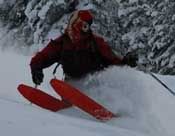1. Compare the strength of different layups materials.
2. Determine if Polyurethane Glue (Gorilla Glue) is a suitable bonding agent.
3. Compare strength differences between epoxy and Polyurethane Glue.
Hopefully you’ll find this information useful.
I started the tests with poly-u glue first since I wanted to see how well it bonds. The reason I chose a cork layup is because someday I’d like to start using it in a ski, perhaps a “green” ski to provide a dampening effect.
All materials below measure 3in wide x 36in long (76.2mm x 914.4mm). Each sample contains 2 layers of maple veneer for the core. All samples were pressed separately without heat.
I plan on conducting more tests with other materials as time goes on.
Material list to date:
FG - Triax 20 oz with 7 carbon fiber strips
Core - maple 1/16in thick (1.6mm)
Cork - .8mm (www.corkstore.com)
AL - .24mm thick (sanded using 80 grit to increase adhesion)
Epoxy - QCM EMV 0049 resin ECA 032 hardener
Polyurethane Glue - Gorilla glue (approx 14 fluid oz used in the 3 tests).
Water - I dampened all the materials before layup as suggested by the makers of Gorilla glue.
VDS
Ptex base
30lb weight (13.6 kilo)
Wixey Digital Angle gauge model WR300 to measure angle of deflection
Layup Samples:

Observations:
As expected the metal layup was extremely firm. I used VDS with the AL to provide better adhesion. It retained 5mm camber where the others had little or no camber. The FG layup was the next firmest with the cork being the softest. No surprise here.
Bonding Results:
No problems with the bonding of materials using Polyurethane glue. As expected the Fiber Glass layup required the most amount of glue in order working into the fibers.
The glue expands 4-5 times when curing. I wondered how this would affect the bonding of the materials. But all the layups bonded firmly.
Torsion testing:
I set up a simple torsion apparatus similar to the ones used in the links below: http://www.skibuilders.com/phpBB2/viewt ... c&start=90
http://www.doctorsnowboard.co.uk/?page_id=305
I noticed during my testing the position of the torsion apparatus in relation to the samples is important as the measurements could vary during the tests if the setup was not consistent from one test to the next.
I conducted torsion tests at a single 6in interval on each sample using a 30lb weight to twist each sample. I zeroed out the Angle meter before conducting each test and then applied the weight.
I’m considering on designing a more reliable torsion apparatus. I noticed as was I testing the sample layups were also bending upward slightly. While I did not want that to occur, I couldn’t prevent it so I had to be as consistent as possible with the setup and positioning of the apparatus.
Torsion Results:

Looking at the numbers above, the metal sample is twice as firm as the FG sample and nearly 4 times more firm than the Cork sample at the 6 inch mark.
Deflection testing:
Each sample layup was clamped 6inches from each end to work tables. A 30lb weight was suspended from the center of the samples. I measured the amount of deflection in millimeters at the center point.
Deflection Results:

Here's some pics:
Fiber glass layup:

Metal layup:
The pic only shows 1 layer of AL but there are 2. One is on the bottom.

Poly-U glue expands:
I was little surprised by the amount the glue expanded. Thought this might weaken the layup but all seems fine.

The sample layups:

Testing Cork:
If I didn't clamp the ends down the cork layup would have folded in half. I did all the Deflections test like this. Notice my high tech weights

Random test:
Wanted to see what epoxy, poly-u glue and wood glue look like when applied to fiber glass. Wood glue is useless. The fiber glass almost cracked when I flexed it. The Poly-u sample flexed evenly like the epoxy sample but seemed to flex easier. The epoxy gave a nice firm even flex.

Over the next 2-3 weeks I'll repeat the sample layups using epoxy and then compare against poly-u glue.










